The Brake Cables Market is estimated to be valued at USD 190.2 million in 2025 and is projected to reach USD 312.7 million by 2035, registering a compound annual growth rate (CAGR) of 5.1% over the forecast period.
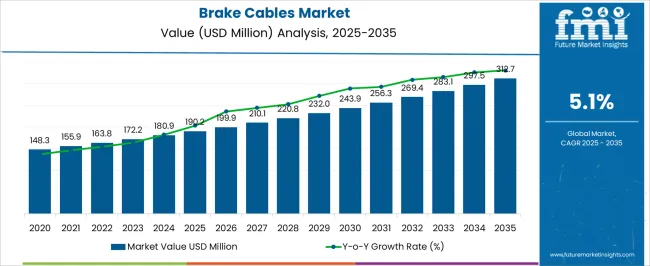
| Metric | Value |
|---|---|
| Brake Cables Market Estimated Value in (2025 E) | USD 190.2 million |
| Brake Cables Market Forecast Value in (2035 F) | USD 312.7 million |
| Forecast CAGR (2025 to 2035) | 5.1% |
The brake cables market is witnessing stable growth, influenced by rising vehicle production, increased focus on driver safety, and technological upgrades in braking systems. With the automotive industry moving toward electrification and lightweight vehicle design, the demand for efficient and durable mechanical components like brake cables remains strong.
Advances in corrosion-resistant materials and multi-strand cable technologies are enhancing performance and longevity. Additionally, regulatory requirements regarding braking safety standards have led to widespread integration of high-performance cables, particularly in compact and mid-sized vehicles.
As vehicle ownership rises globally and OEMs prioritize in-house component sourcing, the market outlook continues to strengthen with demand centered around durability, precision control, and cost-effective solutions.
The market is segmented by Operation, Vehicle Type, and Sales Channel and region. By Operation, the market is divided into Handbrake/Parking Brake and Conventional/Foot Brake. In terms of Vehicle Type, the market is classified into Passenger, Compact, Mid-Size, SUV, Luxury, Two Wheelers, Bicycles, and Others. Based on Sales Channel, the market is segmented into OEM (Original Equipment Manufacturers) and Aftermarket. Regionally, the market is classified into North America, Latin America, Western Europe, Eastern Europe, Balkan & Baltic Countries, Russia & Belarus, Central Asia, East Asia, South Asia & Pacific, and the Middle East & Africa.
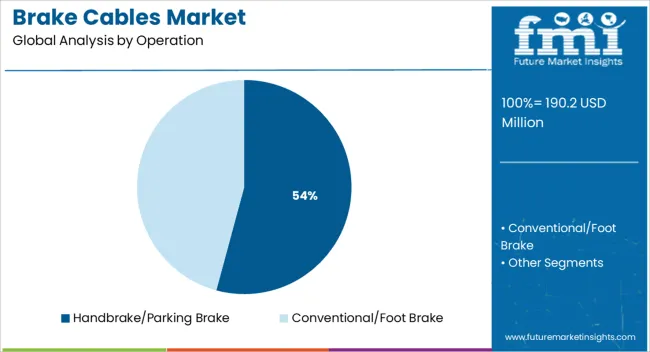
The handbrake parking brake segment is anticipated to represent 54.20% of total revenue by 2025 within the operation category, positioning it as the leading contributor. This dominance is driven by the continued use of manual and semi-automatic braking systems in a wide range of vehicle models.
Handbrake cables are preferred for their mechanical reliability, ease of maintenance, and low-cost design adaptability. Their use remains significant in emerging markets where affordability and mechanical simplicity are prioritized.
Moreover, retrofitting demand in older vehicle models and applications in utility or off-road vehicles contribute to the consistent requirement for handbrake-specific cable systems. This segment's performance is further supported by stable manufacturing standards and integration ease during vehicle assembly.
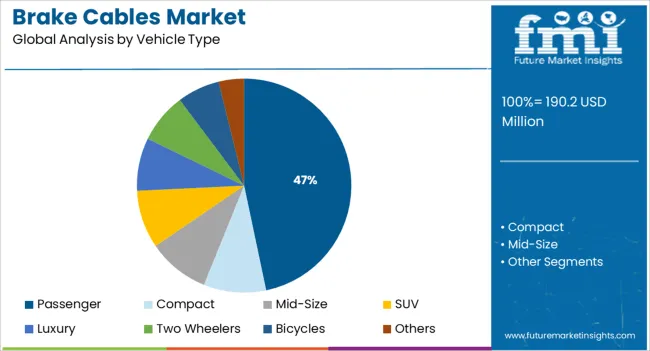
The passenger vehicle segment is projected to account for 46.70% of total market revenue by 2025 within the vehicle type category, marking it as the most dominant segment. This is largely attributed to the rising volume of personal vehicles, especially in urban and suburban markets.
Growing consumer preference for mid-range cars, coupled with consistent demand for economy and compact models, has supported the widespread use of traditional and semi-automated braking systems. Brake cables continue to serve as a cost-efficient and reliable component in this category.
Additionally, global automobile production recovery and increasing emphasis on vehicle safety and control contribute to sustained growth in the passenger vehicle brake cable segment.
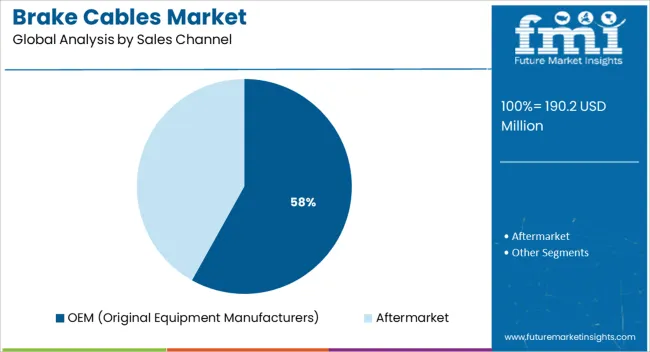
The OEM segment is expected to hold 58.10% of total revenue by 2025 within the sales channel category, making it the largest contributor. This is driven by automakers' preference for sourcing pre-fitted, high-precision components directly from suppliers to ensure performance reliability and manufacturing efficiency.
OEMs favor brake cables that align with evolving vehicle architectures and comply with stringent quality assurance standards. Their preference for customized cable assemblies, reduced assembly time, and long-term supplier partnerships supports this segment's dominance.
As automotive manufacturers increase their focus on integrated safety components and lean supply chains, the OEM channel continues to be the primary source of demand for brake cable systems.
The market analysis for brake cables from 2020 to 2024 exhibited a historical growth rate of 2.1% CAGR, with the popularity of bicycle events and low maintenance costs being the primary factors driving the market expansion from 2020 to 2024.
However, according to the most recent FMI analysis, the brake cable market is expected to grow at a rate of 5.1% between 2025 and 2035. Today, nearly every bicycle manufacturer offers an electric bike, along with many new brands focusing on e-bikes. Their sales have increased steadily, while the sales of conventional bicycles are decreasing moderately. In the EU and Asia Pacific region, the most lucrative part of the bicycle business is now the electric bicycle business. Thus, the rise in e-bike sales is creating a demand for e-bike brake cables. Additionally, Due to improper lubrication in brake cable, it gets rust due to which the demand for brake cable is increasing in the aftermarket.
The rising average life duration of cars, as well as frequent repair and maintenance activities, are driving the expansion of the brake cable market. This is one of the most important variables influencing the growth of the brake cable market throughout the forecast period.
Increasing urbanization in emerging and developing economies around the world, rising employment, rising disposable income, and an increase in the dual-income household of middle-class families are the key factors expected to fuel demand for passenger cars and two-wheelers, thereby fuelling the growth of the automotive brake cable market.
Moreover, the expanding e-commerce and logistics sectors throughout the world raise demand for medium and light-duty cars, which is predicted to accelerate demand for new vehicles and positively impact the brake cable market's growth. Additionally, as environmental safety concerns grow, the demand for electric vehicles grows, and the governments of various nations push for electro-mobility. As a result, increasing demand for electric vehicles is expected to drive growth in the brake cable market throughout the forecast period.
The involvement of different supply structures plays a crucial role in brake cable assembly, including spring, outer cover, and some accessories. The brake cable market is thus largely dependent on the availability of such systems and smooth flow in its value chain. Due to barriers to the supply chain flow, especially for manufacturers who import materials, drive chain technology is not moving as expected. As geographical borders are closed, trade restrictions lead to a slower flow of materials.
East Asia is predicted to dominate the worldwide brake cables market due to increased vehicle fleet size as well as sales of electric automobiles and commercial vehicles in the area. China is expected to drive the region's growth in East Asia due to increased manufacturing of electric automobiles and electric two-wheelers across the country.
Furthermore, government initiatives to promote the growth of electric vehicles and lower taxes on small cars are some of the important factors expected to drive the growth of the brake cables market throughout the forecast period.
Government measures to promote green mobility raise the production of hybrid electric vehicles in several European and South Asian nations, which is likely to boost the growth of the brake cables market. South Asia is expected to grow at a relatively fast rate as a result of improved road infrastructure and rising consumer expenditure across the area.
Rising living standards and the need for simple mobility are two more factors that will promote demand for passenger cars and two-wheelers, which will fuel the growth of the brake cables market.
Furthermore, the Middle East and Africa, as well as Latin America, are predicted to increase significantly during the forecast projected period.
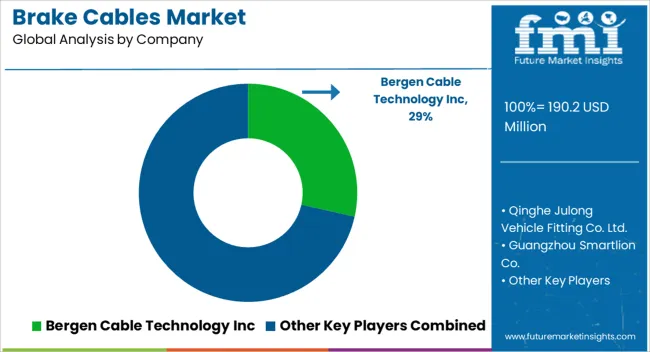
Key players operating in the Brake Cables Market are Bergen Cable Technology Inc, Qinghe Julong Vehicle Fitting Co., Ltd., Guangzhou Smartlion Co., ALLIED WIRE & CABLE, INC., HELLA GmbH & Co. KGaA, CABLE MANUFACTURING & ASSEMBLY (CMA), Remkaflex, Bruin Brake Cables, ABSCOand others.
To build a strong position in the Brake Cables market, key market players are boosting production capacity, expanding sales and distribution networks, product differentiation and new product development, and strategic alliances and partnerships.
| Attribute | Details |
|---|---|
| Growth Rate | CAGR of 5.1% from 2025 to 2035 |
| Base Year for Estimation | 2024 |
| Historical Data | 2020 to 2024 |
| Forecast Period | 2025 to 2035 |
| Quantitative Units | Revenue in USD Million, Volume in 000’Units, and CAGR from 2025 to 2035 |
| Report Coverage | Revenue Forecast, Volume Forecast, Company Ranking, Competitive Landscape, Growth Factors, Trends, and Pricing Analysis |
| Segments Covered | Operation, Vehicle type, Sales Channel, Region |
| Regions Covered | North America; Latin America; Europe; East Asia; South Asia & Pacific; Middle East and Africa |
| Key Countries Covered | USA, Canada, Mexico, Brazil, Germany, Italy, France, United Kingdom, Spain, Benelux, Russia, China, Japan, South Korea, India, ASEAN, Australia and New Zealand, GCC Countries, Turkey, South Africa, North Africa |
| Key Companies Profiled | Bergen Cable Technology Inc; Qinghe Julong Vehicle Fitting Co., Ltd.; Guangzhou Smartlion Co.; ALLIED WIRE & CABLE, INC.; HELLA GmbH & Co. KGaA; CABLE MANUFACTURING & ASSEMBLY (CMA); Remkaflex; Bruin Brake Cables; ABSCO |
| Customization & Pricing | Available upon Request |
The global brake cables market is estimated to be valued at USD 190.2 million in 2025.
The market size for the brake cables market is projected to reach USD 312.7 million by 2035.
The brake cables market is expected to grow at a 5.1% CAGR between 2025 and 2035.
The key product types in brake cables market are handbrake/parking brake and conventional/foot brake.
In terms of vehicle type, passenger segment to command 46.7% share in the brake cables market in 2025.






Full Research Suite comprises of:
Market outlook & trends analysis
Interviews & case studies
Strategic recommendations
Vendor profiles & capabilities analysis
5-year forecasts
8 regions and 60+ country-level data splits
Market segment data splits
12 months of continuous data updates
DELIVERED AS:
PDF EXCEL ONLINE
Automotive Handbrake And Clutch Cables Market
Brake System Market Size and Share Forecast Outlook 2025 to 2035
Brake Override System Market
Brake Shoe Market
Air Brake Systems Market Growth & Demand 2025 to 2035
HCV Brake Components Market
Rail Brake Frame Market
Press Brakes Market Size and Share Forecast Outlook 2025 to 2035
Bicycle Brake Lever Market Size and Share Forecast Outlook 2025 to 2035
Automotive Brake Linings Market Size and Share Forecast Outlook 2025 to 2035
Automotive Brake Hoses and Assemblies Market Size and Share Forecast Outlook 2025 to 2035
Automotive Brake Fluid Market Size and Share Forecast Outlook 2025 to 2035
Automotive Brake Booster and Master Cylinder Market Size and Share Forecast Outlook 2025 to 2035
Automotive Brake Actuation Systems Market Size and Share Forecast Outlook 2025 to 2035
Automotive Brake Shims Market Analysis - Size, Share, and Forecast 2025 to 2035
Automotive Brake System Market Growth - Trends & Forecast 2025 to 2035
Automotive Brake Pad Market - Growth & Demand 2025 to 2035
Automotive Brake Friction Products Market - Trends & Forecast 2025 to 2035
Industrial Brakes and Clutches Market Growth – Trends & Forecast 2025 to 2035
Automotive Brake Tube Market Growth - Trends & Forecast 2025 to 2035

Thank you!
You will receive an email from our Business Development Manager. Please be sure to check your SPAM/JUNK folder too.
Chat With
MaRIA